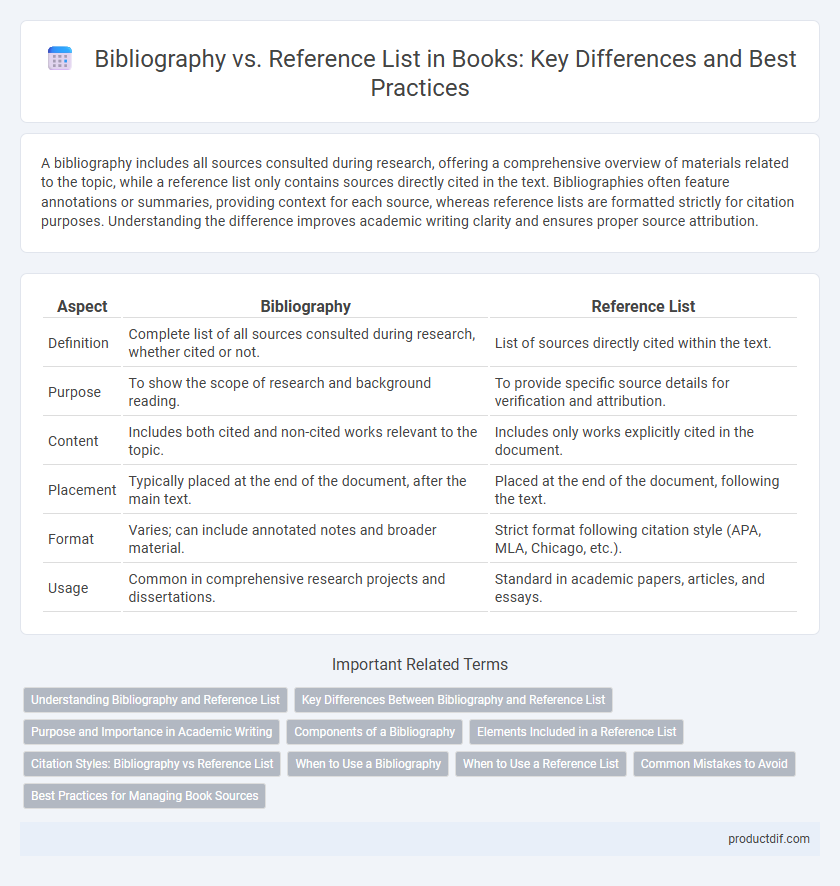A bibliography includes all sources consulted during research, offering a comprehensive overview of materials related to the topic, while a reference list only contains sources directly cited in the text. Bibliographies often feature annotations or summaries, providing context for each source, whereas reference lists are formatted strictly for citation purposes. Understanding the difference improves academic writing clarity and ensures proper source attribution.
Table of Comparison
| Aspect | Bibliography | Reference List |
|---|---|---|
| Definition | Complete list of all sources consulted during research, whether cited or not. | List of sources directly cited within the text. |
| Purpose | To show the scope of research and background reading. | To provide specific source details for verification and attribution. |
| Content | Includes both cited and non-cited works relevant to the topic. | Includes only works explicitly cited in the document. |
| Placement | Typically placed at the end of the document, after the main text. | Placed at the end of the document, following the text. |
| Format | Varies; can include annotated notes and broader material. | Strict format following citation style (APA, MLA, Chicago, etc.). |
| Usage | Common in comprehensive research projects and dissertations. | Standard in academic papers, articles, and essays. |
Understanding Bibliography and Reference List
A bibliography includes all sources consulted during research, offering a comprehensive overview of the materials informing the work, while a reference list contains only the specific sources directly cited in the text. Understanding the distinction helps readers evaluate the depth of research and trace the exact evidence supporting arguments. Proper organization and formatting of both elements adhere to academic standards, enhancing the credibility and clarity of the book.
Key Differences Between Bibliography and Reference List
A reference list includes only the sources directly cited in a book, organized alphabetically by the author's last name, ensuring precise source attribution. A bibliography encompasses all sources consulted during research, covering both cited and background materials, often providing a broader context for readers. Key differences lie in scope, purpose, and content, with the reference list serving strict citation documentation and the bibliography offering comprehensive resource insight.
Purpose and Importance in Academic Writing
A bibliography provides a comprehensive list of all sources consulted during research, offering readers a broader context and demonstrating the depth of study in academic writing. A reference list includes only the sources directly cited within the text, ensuring precise attribution and allowing verification of facts. Understanding the purpose and importance of both enhances scholarly integrity and supports rigorous academic standards.
Components of a Bibliography
A bibliography typically includes all sources consulted during research, such as books, articles, websites, and other materials, regardless of whether they are directly cited in the text. Key components of a bibliography consist of the author's name, title of the work, publication date, publisher, and sometimes the place of publication. Proper formatting and consistency in citation style, like APA, MLA, or Chicago, ensure clear attribution and help readers locate the original sources.
Elements Included in a Reference List
A reference list includes only the sources directly cited within the text, featuring complete details such as author names, publication year, title, and source information to enable precise source retrieval. Each entry follows specific citation style guidelines like APA, MLA, or Chicago, ensuring consistency and clarity. Unlike a bibliography, the reference list excludes sources consulted but not referenced, focusing strictly on works directly used to support the content.
Citation Styles: Bibliography vs Reference List
Citation styles distinguish between a bibliography and a reference list by their scope and purpose; a bibliography includes all sources consulted during research, while a reference list only contains sources directly cited in the text. Styles like APA and MLA mandate reference lists, focusing on precise in-text citations that correspond to full source details. Chicago style often requires a bibliography, offering comprehensive coverage of all materials that informed the work, enhancing the depth of academic scholarship.
When to Use a Bibliography
A bibliography is used when compiling a comprehensive list of all sources consulted during research, including those not directly cited in the text. It provides readers with a broader understanding of the research scope and background materials. Bibliographies are common in academic papers, theses, and books where extensive reading informs the work beyond direct quotations or paraphrasing.
When to Use a Reference List
A reference list is used when citing only the sources directly referenced within the text, ensuring readers can locate the exact works consulted. It typically appears in academic papers and research articles where precision and verifiability are essential. Unlike a bibliography, a reference list excludes sources that influenced the general research but were not explicitly cited.
Common Mistakes to Avoid
Confusing a bibliography with a reference list often leads to including sources not directly cited, which inflates the list beyond the necessary citations. Another common mistake is mixing formatting styles, as bibliographies typically summarize all consulted works, while reference lists include only cited materials, both requiring consistent adherence to specific citation standards like APA or MLA. Neglecting to alphabetize entries or improperly formatting author names and publication dates can further compromise the clarity and professionalism of the work.
Best Practices for Managing Book Sources
A bibliography and a reference list both document book sources but serve different purposes; a bibliography includes all materials consulted, while a reference list only contains works cited. Best practices for managing book sources involve consistent formatting, accurate author attribution, and thorough cross-checking of publication details such as edition, publisher, and year. Utilizing reference management tools like EndNote or Zotero enhances organization and ensures compliance with citation standards like APA, MLA, or Chicago.
Bibliography vs Reference List Infographic

 productdif.com
productdif.com